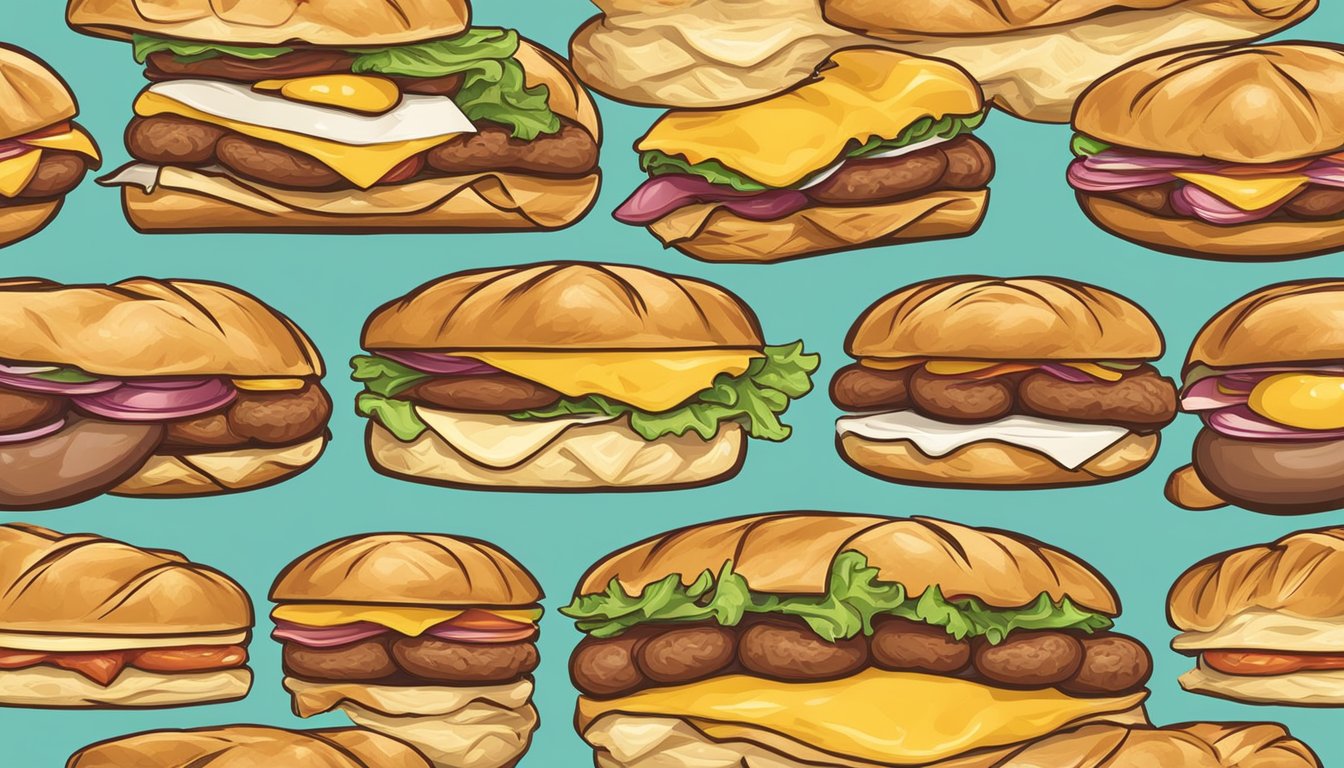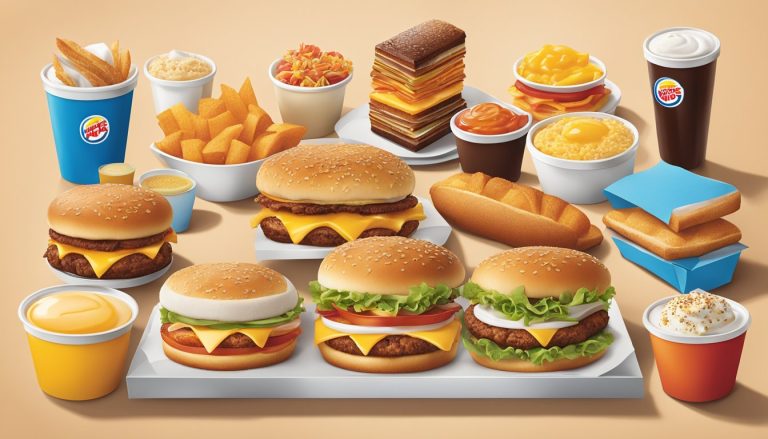The Croissan’wich, introduced by Burger King in 1983, revolutionized the fast-food breakfast landscape. This innovative sandwich combined the flaky, buttery texture of a croissant with savory breakfast fillings, creating a unique offering that set Burger King apart from its competitors. The Croissan’wich quickly became a staple on the menu, offering various options including sausage, bacon, and ham, all paired with egg and cheese.
The creation of the Croissan’wich reflects the evolution of breakfast foods in the fast-food industry. It represents a fusion of traditional French pastry with American breakfast preferences, appealing to customers seeking a more indulgent morning meal option. The success of the Croissan’wich inspired other fast-food chains to experiment with their breakfast menus, leading to a broader range of choices for consumers.
Since its inception, the Croissan’wich has remained popular, adapting to changing tastes and dietary trends. Its enduring presence on Burger King’s menu demonstrates the lasting appeal of this innovative breakfast sandwich. The Croissan’wich’s journey from a novel concept to a breakfast staple illustrates the dynamic nature of fast-food offerings and their ability to shape eating habits.
Historical Origins of the Croissant
The croissant’s journey from Vienna to France spans centuries, involving legendary figures and cultural exchanges. Its evolution transformed a simple crescent-shaped pastry into an iconic French delicacy.
Vienna’s Viennoiserie
The croissant’s precursor, the kipferl, originated in Vienna. This crescent-shaped pastry dates back to at least the 13th century. Bakers in Vienna crafted kipferls from a dense dough, unlike the flaky croissants we know today.
The kipferl gained popularity throughout Austria and neighboring regions. Its distinctive shape may have been inspired by the crescent moon on the Ottoman flag, symbolizing victory in the 1683 Battle of Vienna.
Marie Antoinette’s Influence
Marie Antoinette, an Austrian princess who became Queen of France, is often credited with introducing the kipferl to the French court. While this claim is largely considered a myth, it highlights the cultural exchange between Austria and France.
The young queen’s fondness for Austrian pastries likely influenced French bakers. They began experimenting with Viennese-style baked goods, paving the way for the development of viennoiserie in France.
August Zang’s Boulangerie Viennoise
In 1838, August Zang, an Austrian artillery officer, opened Boulangerie Viennoise in Paris. This bakery introduced Viennese specialties, including the kipferl, to French customers.
Zang’s bakery became immensely popular, inspiring French bakers to create their own versions of Austrian pastries. They adapted the kipferl using puff pastry techniques, resulting in a lighter, flakier texture.
This fusion of Austrian and French baking traditions gave birth to the modern croissant. By the late 19th century, the croissant had become a staple in French bakeries, cementing its place in culinary history.
The Croissant Dough Evolution

The croissant dough has undergone significant changes over time, resulting in the flaky, buttery pastry we know today. These innovations have led to a diverse array of flavor profiles and textures.
Laminated Yeast Dough Techniques
Croissant dough evolved from a simple yeast-based recipe to a complex laminated dough. This technique involves folding butter into the dough multiple times, creating hundreds of thin layers. Bakers typically perform 4 to 6 folds, resulting in an incredibly flaky texture.
The lamination process requires precision and skill. Bakers must maintain the dough at the correct temperature to prevent the butter from melting or becoming too hard. This delicate balance ensures the signature flaky layers and buttery flavor of a well-made croissant.
French bakers refined this method throughout the 20th century, perfecting the texture and taste. Their techniques elevated the croissant to its status as an icon of French pastry.
From Plain to Savory and Sweet Variations
As the croissant gained popularity, bakers began experimenting with different flavors and fillings. The classic crescent-shaped plain croissant remains a staple, but variations have expanded the pastry’s appeal.
Pain au chocolat, often called a chocolate croissant in English, uses the same laminated dough but in a rectangular shape. It features a rich chocolate filling, appealing to those with a sweet tooth.
Savory options like the ham-and-cheese croissant have become popular breakfast and lunch items. These variations maintain the flaky texture while incorporating hearty fillings.
Almond croissants offer another sweet option, filled with frangipane and topped with sliced almonds. Some bakers have even created unique flavors like matcha or fruit-filled croissants.
Rise of the Croissan’wich
The Croissan’wich emerged as a popular breakfast sandwich, combining the flaky texture of a croissant with savory fillings. This innovative creation quickly became a staple on fast food menus across the United States.
Conception at Burger King
Burger King introduced the Croissan’wich in 1983 as part of their breakfast menu expansion. The sandwich featured a croissant-style bun filled with eggs, cheese, and a choice of bacon, sausage, or ham. This novel concept aimed to differentiate Burger King from competitors and appeal to customers seeking a more upscale breakfast option.
The Croissan’wich was an instant hit, driving significant breakfast sales for the company. Its success prompted Burger King to make it a permanent menu item and invest in marketing campaigns to promote the sandwich.
Menu Expansion and Variations
Following the initial success, Burger King introduced several Croissan’wich variations:
- Double Croissan’wich: Featuring extra meat and cheese
- Chicken Croissan’wich: Made with a breaded chicken patty
- French Toast Croissan’wich: Combining sweet and savory flavors
These new options catered to diverse customer preferences and helped maintain interest in the product line. Other fast food chains soon developed their own croissant-based sandwiches, cementing the Croissan’wich’s influence on the industry.
Nutritional Considerations
The Croissan’wich, while popular, faced scrutiny for its nutritional content. A typical Croissan’wich contains:
| Nutrient | Amount |
|---|---|
| Calories | 300-500 |
| Fat | 15-30g |
| Sodium | 600-900mg |
Health-conscious consumers expressed concerns about the high calorie and fat content. In response, Burger King introduced lighter options and provided more transparent nutritional information.
Some locations began offering egg white substitutions and turkey sausage to create lower-calorie versions. Despite these efforts, the Croissan’wich remains a indulgent breakfast choice for many customers.
Impact on French and Global Cuisine

The Croissan’wich has left an indelible mark on both French culinary traditions and international fast food markets. Its unique fusion of flaky pastry and savory fillings bridges classic French baking with modern convenience food.
Croissant’s Role in French Cuisine
The croissant holds a revered place in French pastry. Boulangeries across France showcase golden, crescent-shaped croissants as a breakfast staple. The Croissan’wich built on this cultural significance, adapting the beloved pastry into a versatile sandwich format.
This innovation sparked debates among culinary purists. Some viewed it as a creative evolution of French cuisine. Others saw it as a departure from tradition. Regardless, the Croissan’wich expanded the croissant’s role beyond sweet applications.
From Boulangeries to Fast-food Chains Worldwide
The Croissan’wich concept quickly spread beyond French borders. Major fast-food chains adopted the idea, introducing it to global markets. This move brought a taste of French pastry to millions of consumers worldwide.
In the United States, Burger King popularized the Croissan’wich in the 1980s. Other chains followed suit with their own variations. The trend highlighted the growing international appeal of French-inspired fast food.
• McDonald’s – Introduced the McGriddle
• Dunkin’ Donuts – Launched croissant breakfast sandwiches
• Starbucks – Offers various croissant-based items
This global expansion cemented the Croissan’wich’s status as a cross-cultural culinary icon.
Cultural Significance and Celebrations

The croissant’s influence extends far beyond breakfast tables, inspiring dedicated days and innovative creations. Its cultural impact is seen in annual festivities and culinary fusions that capture global imaginations.
Croissant Day and Widespread Popularity
January 30th marks National Croissant Day, celebrating the pastry’s worldwide appeal. This day highlights the croissant’s journey from Viennese origins to French icon and global favorite. Bakeries often offer special promotions, while food enthusiasts share their love for croissants on social media.
The croissant’s popularity has led to its appearance in popular culture, featuring in films, literature, and art. It’s often associated with French culture, despite its Austrian roots. A common myth links Marie Antoinette to the pastry’s introduction in France, though this claim lacks historical evidence.
Crossover Creations like the Cronut
The croissant’s versatility has inspired culinary innovations. The most famous is the Cronut, created by pastry chef Dominique Ansel in 2013. This croissant-doughnut hybrid became a global sensation, with people queuing for hours to taste it.
Other crossover creations include the Croissan’wich, merging croissants with sandwich fillings. These inventions demonstrate the croissant’s adaptability and enduring appeal. They also reflect changing food trends and consumer preferences for novel, indulgent experiences.
Such creations have sparked debates about tradition versus innovation in pastry-making. They’ve also influenced menu offerings in cafes and bakeries worldwide, further cementing the croissant’s cultural significance.
The Future of Breakfast Pastries

Breakfast pastries are evolving to meet changing consumer preferences and dietary needs. New innovations and health-conscious alternatives are reshaping traditional breakfast menus.
Innovations in Breakfast Menus
Plant-based croissants are gaining popularity, offering flaky textures without animal products. Some bakeries now use alternative flours like almond or coconut to cater to gluten-free diets. 3D-printed pastries are emerging as a futuristic option, allowing for intricate designs and customized shapes.
Savory breakfast pastries are on the rise. Chefs experiment with fillings like smoked salmon, spinach, and feta cheese. Miniature versions of classic pastries cater to portion-control trends.
Fusion pastries blend cultural influences. Matcha-flavored croissants and mochi-filled Danish pastries appeal to adventurous eaters. Seasonal and limited-edition flavors keep breakfast menus fresh and exciting.
Health Trends and Alternative Recipes
Whole grain and fiber-rich pastries address health-conscious consumers’ needs. Bakers incorporate ingredients like chia seeds, flaxseed, and oats for added nutritional value. Low-sugar and sugar-free options use natural sweeteners like stevia or monk fruit.
Protein-enriched pastries target fitness enthusiasts and busy professionals. Some recipes include protein powders or Greek yogurt fillings. Vegan croissants made with plant-based butter alternatives cater to those following plant-based diets.
Functional ingredients like adaptogens and probiotics find their way into breakfast pastries. These additions aim to boost energy, improve digestion, or reduce stress. Reduced-calorie versions of classic pastries use innovative baking techniques to maintain taste while cutting fat content.




